Final Exam Review PDF

| Title | Final Exam Review |
|---|---|
| Course | General Chemistry II |
| Institution | University of Guelph |
| Pages | 5 |
| File Size | 234.9 KB |
| File Type | |
| Total Downloads | 63 |
| Total Views | 583 |
Summary
REVIEW QUESTIONS – PARTIAL SOLUTIONSMultiple ChoiceQuestions 1 to 3 to be discussed in class Thursday or Friday (April 5/6).4. The oxidation state of P in Na 2 HPO 4 isA) +1 B) –1 C) +5 D) +3 E) –STRATEGY:Assign oxidation numbers to the most common elements, i., H, O, and then use periodic trends. S...
Description
REVIEW QUESTIONS – PARTIAL SOLUTIONS Multiple Choice
Questions 1 to 3 to be discussed in class Thursday or Friday (April 5/6). 4. The oxidation state of P in Na2HPO4 is A) +1 B) –1 C) +5
D) +3
E) –3
STRATEGY: Assign oxidation numbers to the most common elements, i.e., H, O, and then use periodic trends. Since this is a salt, Na is +1 and HPO4 will add up to -2. H is +1 and O is -2, so just solve for P: OR
For the whole salt, Na2HPO4: 2(+1) + 1 + x + 4(-2) = 0 Isolating only the polyatomic ion, HPO42-: 1 + x + 4(-2) = -2 Solving for x, x = +5
5. Given Zn(s) + Sn2+(aq) → Sn(s) + Zn2+(aq) The standard free energy change in kJ/mol for this reaction at 298K is: A) 1.2×102
B) –21.2
C) –60
D) –1.2×102
E) 60
STRATEGY: The standard free energy can be related to the standard cell potential via the relationship: ∆G° = –nFE° To solve for ∆G°, one first needs to determine E°, as well as n. From the data given, the following SRP equations can be selected: Zn2+ (aq) + 2e– → Zn(s); E° = – 0.76V Sn2+(aq) + 2e– → Sn(s); E° = – 0.14V E°(cell) = E°(SRP for cathode) – E°(SRP for anode) = – 0.14V– (–0.76V) = 0.62V; n = 2 ∆G° = –nFE° = – (2 moles e– )(96485 C/mol e– )(0.62 J/C) = –119641 J = –120 kJ
6. The value of the equilibrium constant, K, for the reaction Br2(l) + H2O(l) → H+(aq) + Br–(aq) + HOBr(aq) at 298K is: A) 1.6×10–9 B) 2.5×104 C) 4.1×10–5 D) 6.1×108
E) 1.2×10–4
STRATEGY: An equilibrium constant can be related to the standard cell potential via the relationship: ∆G° = –nFE° = –RT ln K ∴ E° = RT/nF ln K Rearrange the second equation to isolate for K, i.e., K = exp{nFE°/RT} To solve for K, one needs to determine E°, as well as n, through separating the overall equation into its two half reactions, i.e., Br2(l) + 2e– → 2Br–(aq); E° = +1.06V HOBr(aq) + H+(aq) + 2e– → Br–(aq) + H2O(l); E° = +1.32V Based on the overall reaction, the first equation is the reduction and the second is the oxidation, i.e., E°(cell) = E°(SRP for cathode) – E°(SRP for anode) = +1.06V– (1.32V) = – 0.26V; n = 2 K = exp {nFE°/RT} = exp {(2 moles e– × 96485 C/mol e– × –0.26 J/C)/(8.314 J/molK × 298K)} K = e–20.25 = 1.6 × 10–9
7. A current is passed through a molten mixture of ZnI2 and KCl. The product at the cathode is: A) K+ B) Cl– C) I2 D) Zn E) K 1
STRATEGY: This is an electrolysis question using a molten mixture. “Molten” means the salt mixture has been heated to the point where a liquid forms. This allows the charged particles to move and complete a circuit. Note, there is NO water present. To determine what is formed at the cathode, one first needs to identify all the reactants present and list all the possible reactions. The reduction reaction(s) are then isolated and the final answer is based on which reduction has the most positive standard potential. If ZnI2 and KCl is present, then the reactants are: Zn2+(l), I–(l), K+(l) and Cl–(l). Possible redox reactions (placing the reactants on the reactant side of the equation): Reduction: Oxidation: Reduction: Oxidation:
Zn2+(l) + 2e– → Zn(l); E° = – 0.76V 2I–(l) → I2(l) + 2e–; E° = – 0.535V (equation was flipped to have reactant on correct side.) K+(l) + e– → K(l); E° = – 2.92V 2Cl–(l) → Cl2(g) + 2e–; E° = – 1.36V (equation was flipped to have reactant on correct side.)
The reduction reaction Zn2+(l) + 2e– → Zn(l) has the most positive potential, so the product formed at the cathode will be Zn in a molten state.
8. Use the following experimental data for NO(g) + Cl2(g) → NOCl2(g) Trial 1 2 3 4
[NO] 1.01×10–2 1.02×10–2 2.02×10–2 3.02×10–2
[Cl2] 5.30×10–2 1.05×10–1 1.51×10–1 1.53×10–1
The order of Cl2(g) in the rate law is: A) 1 B) none of these
C) 2
Initial Rate 5.00×10–2 1.99×10–1 9.02×10–1 1.34 D) 3
E) 0
STRATEGY: Based on the table of results provided, choose two trials where the [NO] remains the same but the [Cl2] changes. This will isolated the effect of only Cl2(g) on the rate of the reaction. For example, upon comparing trial #2 and #1, the [Cl2] doubled and the rate quadrupled. This indicates second order kinetics in Cl2.
9.
Tritium is radioactive and decays by a first order process with a half life of 12.5 years. If an experiment starts with 1.00×10–6 moles of tritium then the number of moles of tritium left after 4.5 years is A) 1.1×10–7 B) 7.8×10–7 C) 3.6×10–7 D) 4.8×10–6 E) 1.0×10–9
STRATEGY: If you know the order and the half life, one can find the rate constant. Based on the integrated rate law, if one knows the initial amount of material (doesn’t have to be concentration – can be moles, pressure, etc.), the rate constant and the time, then the final amount remaining can be determined, i.e., Radioactive decay follows 1st order kinetics. 1st order half life equation: k = ln 2/ t½ = 0.693/12.5 years = 0.0555 years–1 1st order integrated rate law: ln A = ln A0 – kt ln A = ln 1.00×10–6 moles – (0.0555 years–1)(4.5 years) = –14.07 A = exp {–14.07} = 7.8× ×10–7 moles
10. The rate constant for a particular first order reaction at 500°C is 1.20×10–4 s–1. The rate constant for this reaction at 600°C is 6.80×10–3 s–1. The activation energy in kJ/mol for this reaction is: A) 27.4 B) 226 C) 318 D) 3.36 E) 33.6 2
STRATEGY: The question gives two rate constants at two different temperatures. The only way to solve for the activation energy is to use: ln(k2/k1) = (Ea/R){(T2 – T1)/(T1 × T2)} where, k1 = 1.20×10–4 s–1 @ T1 = 500°C = 773K k2 = 6.80×10–3 s–1 @ T2 = 600°C = 873K ∴ln(6.80×10–3/1.20×10–4) = (Ea/8.314 J/mol K){(873K – 773K)/ (773K × 873K)} ln (56.667) = (Ea/8.314 J/mol K) × 1.482×10–4 K–1 4.037 /1.482×10–4 K–1 = Ea/8.314 J/mol K 27241 K ×8.314 J/mol K = Ea Ea = 226 000 J/mol = 226 kJ/mol
PROBLEM QUESTIONS: Questions 11-13 and 18 to 22 To Be Discussed Thursday, April 5 or Friday, April 6 14. Balance the reaction: IO3–(aq) + I–(aq) → I3–(aq) which occurs in acidic solution. STRATEGY: Identify the oxidation numbers for each element involved in the reaction. Based on the changes in oxidation numbers, isolate the two half reactions. Balance each half reaction based on the presence of acid and then unite the two half reaction to form the overall reaction, i.e., IO3–: O is -2 and I is (x – 6 = -1), x = +5;
Steps
I in I– is -1;
I3– has (3x = –1), x = –⅓
Reduction
Oxidation
ID two half reactions:
IO 3– (aq) → I 3–(aq)
A (Balance the strange atoms):
3IO 3–(aq)
E (Balance oxidation #’s with e ’s ): –
I (Balance charge with H +):
→
3 × +5 = +15
I–(aq) → I3 –
I3– (aq)
3I
3 × –⅓ = –1
3 × 3= 9
(aq)
I3–(aq) 3 × –⅓ = –1
–
3I–(aq) → I3 (aq) + 2e
3 × –⅓ = –1
3IO3–(aq) + 16e– + 18H+(aq) → I3–(aq) O (Balance O’s with H2O):
→
3×-1 = – 3
3IO3–(aq) + 16e– → I3–(aq) (3 × –1) + (16× –1) = –19
(aq)
–
–
3I–(aq) → I3–(aq) + 2e– Balanced!
0
3IO3–(aq) + 16e– + 18H+(aq) → I3–(aq) + 9H2O(l)
(3I–(aq) → I3– (aq) + 2e–) ×8 – – 24I–(aq) → 8I 3 (aq) + 16e – – + – Combine to get: 3IO3 (aq) + 18H (aq) + 24I (aq) → 9I 3 (aq) + 9H2O(l) Reduce to a Final Answer of: IO3–(aq) + 6H+ (aq) + 8I– (aq) → 3I3– (aq) + 3H2O(l)
U (Unite the two half reactions):
– + 3IO 3– (aq) + 16e + 18H (aq) → I 3– (aq) + 9H2O (l)
15. Balance the following equation in basic solution: OCl–(aq) + SCN–(aq) → SO42–(aq) + CO32–(aq) + NO3–(aq) + Cl–(aq) STRATEGY: 1. 2. 3.
Identify what is oxidised and reduced. Separate into two half reactions. Balance each reaction individually.
4. Unite the two half reactions by matching the amount of electrons. Note: For SCN–, start with S having same oxidation number as O (since from same group in the periodic table). Since S is -2, then the sum of the oxidation numbers from both C and N must add up to +1. What common oxidation numbers for C and N add up to +1? Ans: +4 & -3, as N is more electronegative than C. Therefore both S (ox. #’s: -2 to +6) and N (-3 to +5) are oxidised in the same equation:
3
2–
SCN–(aq) → SO4
(aq)
+ CO32–(aq) + NO3 –(aq) + 8e– (from S) + 8e– (from N)
Steps
Reduction
Oxidation
ID two half reactions:
OCl– (aq) → Cl– (aq)
SCN–(aq) → SO4 2–(aq) + CO3 2–(aq) + NO3 –(aq)
A (Balance the strange atoms):
OCl– (aq) → Cl– (aq)
E
(Balance ox. #’s with e–’s ):
+1
SCN–(aq) → SO4 2–(aq) + CO3 2–(aq) + NO3 –(aq) -2 +4 -3
–1
I (Balance charge with H+):
–1 + (2× –1) = –3
–1
–1
O
U (Unite the two ½ reactions): =
+4
+5
-2 + -2 + -1 + (16× –1) = –21
SCN–(aq) + 20OH–(aq)→ SO42–(aq) + CO32–(aq) + NO3–(aq) +16e–
OCl–(aq) + 2e– → Cl–(aq) + 2OH–(aq)
O (Bala nce O’s with H2O):
+6
SCN–(aq) → SO42–(aq) + CO32–(aq) + NO3–(aq) +16e–
OCl–(aq) + 2e– → Cl–(aq)
2 O’s
20 O’s
4 + 3 + 3 = 10 O’s
OCl–(aq) + H2O(l) + 2e– → Cl–(aq) + 2OH–(aq)
SCN–(aq) + 20OH–(aq)→ SO42–(aq) + CO32–(aq) + NO3–(aq) + 10H2O(l) +16e–
(OCl– (aq) + H 2O(l) + 2e– → Cl– (aq) + 2OH–(aq))×8
SCN–(aq) + 20OH–(aq)→ SO4 2–(aq) + CO 32–(aq) + NO3 –(aq) + 10H2 O(l) +16e–
8OCl–(aq)
8Cl–(aq)
(aq)
+ 4OH–(aq) → SO4
+ 8H2O(l) + 16e →
–
Final answer: 8OCl
–
(aq)
+ SCN
–
+
16OH–(aq) 2–
(aq)
+ CO3 2–(aq) + NO3–(aq) + 8Cl–(aq) + 2H2O(l)
16. The overall reaction in the lead storage battery is Pb(s) + PbO2(s) + 2H+(aq) + 2HSO4–(aq) → 2PbSO4(s) + 2H2O(l); E° = 2.04V at 298K a) Calculate E at 298K for this battery when [H+] = [HSO4–] = 4.5M b) For the cell reaction in the lead storage battery, ∆H° = – 315.9 kJ and ∆S° = 263.5 J/K. Calculate E° at –20°C. c) Calculate E at –20°C when [H+] = [HSO4–] = 4.5M STRATEGY: In a) to calculate E, one needs to use the Nernst equation: E = E° – RT/nF ln Q. E° and values needed for Q are given. The only value missing is n, which can be determined by identifying the two half reactions and the total number of electrons transferred, e.g., Pb(s) → PbSO4(s) + 2e– and PbO2(s) + 2e– → PbSO4(s); n = 2. For b) to calculate E° based on ∆H° and ∆S°, one first needs to determine ∆G° at –20°C (253 K) and then convert to E°, or just use the relationships: ∆G° = ∆H° – T∆S° = –nFE° and solve for E° directly. For c), again the Nernst equation is used, only this time the new E° value and the new temperature are used. (Note: one cannot use the special Nernst constant since T ≠ 298K). a)
E = E° – RT/nF ln Q, where E° = 2.04V, n = 2, Q = 1/[H+]2[HSO4–]2 = 1/ (4.5)4 = 2.44×10–3 E = 2.04V – (8.314 J/mol K × 298K)/(2 × 96485 C/mol) ln 2.44×10–3 E = 2.12 V (3 sig figs due to the subtraction at the end of the calculation)
b)
∆G° = ∆H° – T∆S° = –nFE° –315.9×103 J – (253 K × 263.5 J/K) = –(2 moles × 96 485 C/mol)E° –382600 J = – 192970 C × E° E°° = 1.98 V @ –20°°C
c)
E = 1.98V – (8.314 J/mol K × 253K)/(2 × 96485 C/mol) ln 2.44×10–3 = 2.05 V @ –20°°C
17. Consider a voltaic cell based on the following half reaction VO2+(aq) + 2H+(aq) + e– → VO2+(aq) + H2O(l) ; E° = 1.00V Zn2+(aq) + 2e– → Zn(s); E° = –0.76V a) Write the overall cell reaction which is spontaneous under standard conditions and determine E° for this cell at T = 298K. b) Determine the cell potential, E, at T = 298K if [VO2+] = 2.0M, [H+] = 0.50M, [VO2+] = 1.10×10–2 M and [Zn2+] = 1.0×10–1 M STRATEGY:
4
Based on the two half reactions given, determine which is the oxidation (more negative standard potential) and flip the equation (and its potential) to determine the overall cell reaction and the standard cell potential. To find the cell potential in b), use the Nernst equation.
a) VO2 +(aq) + 2H+(aq) + e– → VO2+(aq) + H2O(l); E° = 1.00V(need to multiple equation by 2 to match e– ’s) Zn2+(aq) + 2e– → Zn(s); E° = –0.76V (need to flip equation & voltage to form oxidation rxn) E° = +1.00V (voltage does not double!) 2VO2+(aq) + 4H+(aq) + 2e– → 2VO2+(aq) + 2H2O(l); Zn(s) → Zn2+(aq) + 2e–; E° = +0.76V 2VO2+(aq) + 4H+(aq) + Zn(s) → 2VO2+(aq) + 2H2O(l) + Zn2+(aq); E°° = +1.76V b) E = E° – RT/nF ln Q, where E° = 1.76V, n = 2, Q = [VO2+]2[Zn2+]/[VO2+]2[H+]4 Q = [1.10×10–2]2[1.0×10–1]/[2.0]2[0.50]4 = 4.84×10–5 E = 1.76V – (8.314 J/mol K × 298K)/(2 × 96485 C/mol) ln 4.84×10–5 E = 1.89 V
23. A proposed mechanism for the gas phase reaction of bromine with bromoform is: Br2(g) 2Br(g) K1, fast equilibrium
Br(g) + CHBr3(g) → HBr(g) + CBr3(g) k2, slow CBr3(g) + Br(g) → CBr4(g) k3, fast Write the overall reaction and find an expression for the rate law. STRATEGY: Find the overall reaction by adding all the elementary reaction together and cancelling out any intermediate(s) or catalyst(s). The rate is based on the slowest step in the mechanism (i.e., rate determining step). Write a rate law based on the molecularity of the reactants in the slowest elementary reaction. Check to see that no intermediates are in the rate law. If so, then form a substitution for the intermediate based on the equilibrium reaction.
Overall Rxn: Br2(g) + CHBr3(g) → HBr(g) + CBr4(g) Note: Br(g) and CBr3(g) are both intermediates in this mechanism. There is no catalyst present. Rate law for slowest step: Rate = k2[Br][CHBr3] – need to find a substitution for Br Based on the fast equilibrium: K1 = [Br]2/[Br2]; [Br] = K1½ [Br2]½ (OR alternatively: [Br] = (k1/k-1)½ [Br2]½ ) ½ ½ ½ ½ –½ –1 Rate = K1½ k2 [Br2] [CHBr3] = (k1/k-1) k2 [Br2] [CHBr3] = kobs[Br2] [CHBr3] (units of k = M time )
24. Plot the energy profiles (and identify Ea, forward) for the following reaction mechanisms: (i) a slow step followed by a fast step (overall endothermic reaction ) (ii) a fast step followed by a slow step (exothermic reaction) STRATEGY: 1. 2. 3.
Slow steps are slow because they have greater activation energy than a fast step. If a reaction is endothermic, the reactants have lower energy than the products. Energy profiles outline the rxn process through plotting the energy change as reactants move towards products. For every step in a mechanism, there will be "peak" to profile reactant(s), transition state and product(s). Below is an example for a reaction that is endothermic and has a mechanism with a slow step, followed by a fast step. The Ea, forward for the overall reaction is equivalent to Ea for the first, slow step.
Ea, fwd
Below is an example for a reaction that is exothermic and has a mechanism with a fast step, followed by a slow step. The Ea,fwd for the overall reaction is measured from the reactants (at the very beginning of the plot) to the top of the second peak.
E a, fwd Ea, rev
Ea, rev
5...
Similar Free PDFs

Chem Final Exam Review
- 12 Pages

Final Exam - Review notes
- 92 Pages

Bio Final Exam Review
- 2 Pages

Final EXAM Review booklet
- 5 Pages
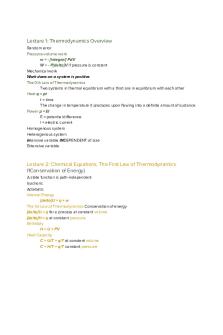
CHEM303 final exam review
- 4 Pages

Psychology Final Exam - Review
- 13 Pages
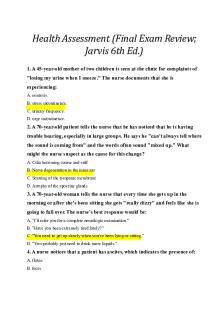
Jarvis Final Exam Review
- 12 Pages
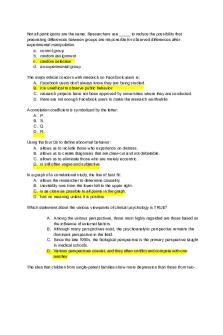
Final exam review
- 96 Pages
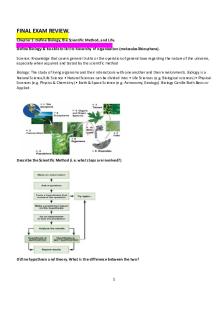
Final Exam Review
- 48 Pages
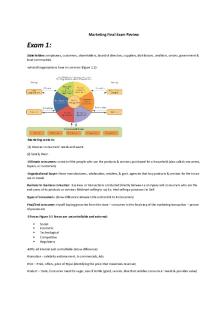
Marketing Final Exam Review
- 15 Pages
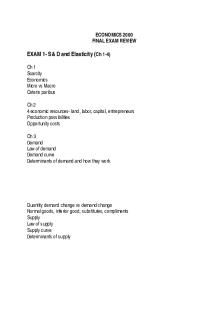
Final exam review
- 8 Pages
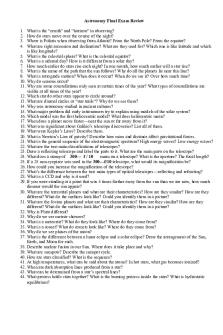
Astronomy Final Exam Review
- 2 Pages
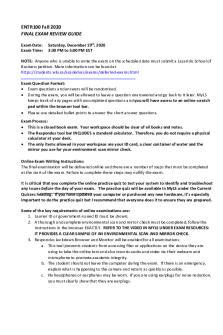
Final Exam Review Guide
- 4 Pages

Final exam review flsp4420
- 5 Pages

Theo Final Exam Review
- 16 Pages

Entrepreneurship final exam review
- 33 Pages
Popular Institutions
- Tinajero National High School - Annex
- Politeknik Caltex Riau
- Yokohama City University
- SGT University
- University of Al-Qadisiyah
- Divine Word College of Vigan
- Techniek College Rotterdam
- Universidade de Santiago
- Universiti Teknologi MARA Cawangan Johor Kampus Pasir Gudang
- Poltekkes Kemenkes Yogyakarta
- Baguio City National High School
- Colegio san marcos
- preparatoria uno
- Centro de Bachillerato Tecnológico Industrial y de Servicios No. 107
- Dalian Maritime University
- Quang Trung Secondary School
- Colegio Tecnológico en Informática
- Corporación Regional de Educación Superior
- Grupo CEDVA
- Dar Al Uloom University
- Centro de Estudios Preuniversitarios de la Universidad Nacional de Ingeniería
- 上智大学
- Aakash International School, Nuna Majara
- San Felipe Neri Catholic School
- Kang Chiao International School - New Taipei City
- Misamis Occidental National High School
- Institución Educativa Escuela Normal Juan Ladrilleros
- Kolehiyo ng Pantukan
- Batanes State College
- Instituto Continental
- Sekolah Menengah Kejuruan Kesehatan Kaltara (Tarakan)
- Colegio de La Inmaculada Concepcion - Cebu